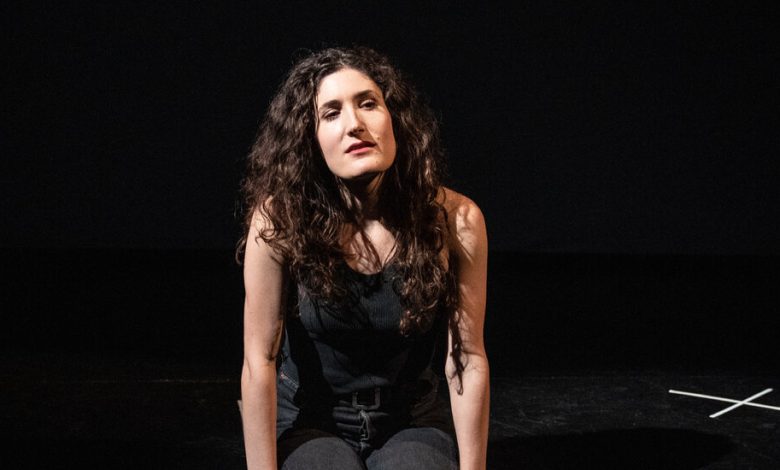Review: In ‘Kate,’ Tracing the Tears of a Clown

There are more than 40 individual muscles in the human face, and when Kate Berlant tries to cry, she gives all of them a workout. An open-mouthed frown suggests the mask of Greek tragedy; a pout transforms her into a gargoyle. Her brow furrows and smooths. Eyes squint, widen and cross. Lips quiver. Nostrils flare. A camera captures each shift, and a projector then throws the image onto a giant screen. Still, the tears don’t come. Some people in the audience will laugh at this. Some won’t. Some will be too busy wondering if this bit is ha-ha funny or cringe funny or merely mortifying, a convergence of pleasure, perplexity and embarrassment that is, I would hazard, exactly where Berlant and her 15-foot-face face want us.
A grande dame of experimental comedy, Berlant is a thinking woman’s comic. To put it a little more precisely, she is a comic for all the girls out there who think too much. Her latest experiment, at the Connelly Theater, is “Kate,” directed by Bo Burnham, a brainy, busy, dizzy, prankish one-woman show. The confessional solo is a hallowed form downtown; Berlant desecrates it from every side. She plays with its creeds the way that a cat might toy with a mouse — teasing, batting, swiping, mauling.
The show positions Berlant as Kate, an actress with a semi-traumatic origin story and a style too brash and crass for film work. “Kate” is structured — loosely, like drawstring pants — around Kate’s failed attempts, from childhood onward, to cry on camera. Crying functions here as the high-water mark (salt water, presumably) of actorly truth and authenticity. But what is authenticity anyway? And why would you go looking for it at a theater-comedy hybrid like this one? Sincerity doesn’t live here anymore. Joke’s on you.
Impatient, stylized, cerebral, Berlant’s comedy has never been for all markets. (Or maybe she’s not for … men?) Nearly a decade ago, my colleague, Jason Zinoman, described her as “not to everyone’s taste.” Marc Maron, on a recent episode of the WTF podcast, introduced her this way: “She’s an odd presence. But funny.” Her comedy resembles an infinite recursion, a hall of mirrors in which the reflections rarely flatter.
Here, the auto-fictional games begin as soon as you enter the lobby of the Connelly, a dainty theater folded into an East Village side street. Berlant is already everywhere, in a way that suggests both formal daring and pathological narcissism. Her stage outfit is on display behind a glass vitrine, as though borrowed from the Met’s Costume Institute. Her notebook is on exhibit, too. You can buy a beer at the “Katecessions” stand, pose with black-and-white photos of Berlant, visit a reproduction of her childhood living room, view the lunar phase at the moment of her birth. And there in the middle of it all is Berlant herself, in dark glasses and with luxuriant curls, wearing a sign that says, “Ignore Me.”
If her previous projects — her film and television cameos; her sketch show with John Early; her podcast with Jacqueline Novak, Poog — have not yet won you over, how you respond to “Kate” may have to do with how much you enjoy seeing theatrical tropes savaged. (Me, I enjoy that a lot.) The accents, the miming, the assumption of multiple characters, the buildup to some terrible trauma, all are satirized here. Berlant is very much in on each joke. But Kate, her serious and self-possessed character, is not.
“I’m going to be talking about something I’ve never talked about,” she says in an early scene, in the sleek, practiced rhythms of someone who has spent too long in the rehearsal room. “See, I have this secret? The show is a mess. It’s about me, so of course it is.”
Berlant can run hot, like a Cassavetes heroine with big theater kid energy, tumultuous, but bright with it. Burnham’s more detached style, most conspicuous in the filmed segments, cools her down, further levering open the gap between performer and character. The Kate of the show insists that everything depends on whether or not she can cry on camera. (Part of the show’s schtick is that there’s a Disney+ executive whom she wants to impress.) But Berlant and Burnham seem up to something more destabilizing, the suggestion that authenticity is just one more act, that truth is, at best, contingent and transitory. Although “Kate” borrows elements of Berlant’s biography, it’s fiction through and through, which means that it withholds the very thing the lobby teases: knowledge of Berlant herself.
It’s a great joke, if a nihilistic one. And here’s one more, a swipe at the theater itself. Because if you really were going to reveal your terrible secret, unpacking your heart with words, why would you do it for 150 people on the Lower East Side? Wouldn’t you just put that mess online?
Here is how Kate, in a moment of outrage explains it: “Do you realize that if I posted a video to Instagram and it got 150 likes, I would kill myself?”
Kate
Through Oct. 8 at the Connelly Theater, Manhattan; kateshow.net. Running time: 1 hour 20 minutes.





